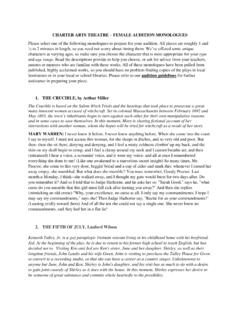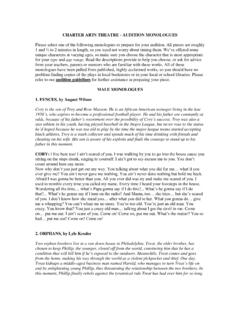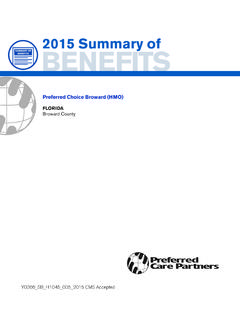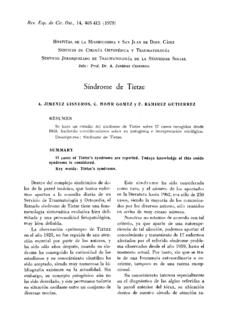Transcription of Teacers Des Reerence Practical Inratin r …
1 Teachers Desk Reference: Practical Information for Pennsylvania s TeachersInclusive PracticesAs a classroom teacher, you play an important role in the lives of your students. One of the many responsibilities you are charged with is to promote a safe and welcoming classroom and school community where individual dif-ferences are valued, embraced, and evident. Building an inclusive classroom community means implementing practices where all students, regardless of cognitive or academic level, have opportunities to be included in the general education classroom, participating in standards-based curriculum. Inclusive school settings are characterized by: All students belonging and being valued as equal members of the school community Intentionally and meaningfully engaging students with disabilities in a wide range of learning opportunities, activities, and environments that are available to all children, including participation in the general education curriculum, nonaca-demic, and extracurricular activities Implementing goals and objectives that are aligned with the state standards.
2 As well as implementing goals that are student specific in the general education classroom with the appropriate supple-mentary aids and services Developing and implementing instruc-tional strategies and methods that increase the participation and progress in the gen-eral education curriculum of students with disabilities Individuals with Disabilities Education Improvement Act (IDEA 2004) IDEA 2004 supports inclusive practices by requiring that to the maximum extent appropriate, children with disabilities, including children in public or private institutions or other care facilities, are educated with children who are nondisabled; and that special classes, separate schooling, or other removal of children with disabilities from the regular educational environment occurs only when the nature or severity of the disability of a child is such that education in regular classes, with the use of supplementary aids and services, cannot be achieved satisfactorily (IDEA, 2004, 612(a)(5)).
3 2 Benefits of Inclusive PracticesEvery day, you are faced with the opportunity to meet the diverse learning and behavioral needs of your students. Educating students with and without disabilities together in Components of Inclusive Classrooms and SchoolsTeachers must have an awareness of the compo-nents of inclusive classrooms and schools. These components provide the building blocks neces-sary for creating a safe and welcoming school community where individual differences are val-ued and embraced. These components are: Leadership, School Climate and Structure, Student Placement, Family and Community Involvement, Collaborative Practices, Instructional Practices, and Supplementary Aids and Services. inclusive school environments provides many benefits. These benefits extend to students with and without disabilities, as well as their families and for StudentsBenefits for TeachersBenefits for Families Developing an appreciation and respect for the unique characteristics and abilities of each individual I ncreasing abilities to help and support all classmates, with a sensitivity toward others differences Providing opportunities to experience diversity of society in an educational environment Enabling development of friendships and strengthening a positive self-image by engaging in activities with peers Promoting opportunities to communicate, self advocate.
4 And be educated with same-age peers Exchanging information about instructional activities and teaching strategies, thus expanding the skills of both general and special educators Developing teamwork and collaborative problem-solving skills to creatively address challenges regarding student learning Promoting the recognition and appreciation that all students have strengths and are contributing members of the school community Feeling positive about themselves and their children by seeing their children accepted by others, successful in the inclusive setting, and belonging to the community where they live Feeling positive about themselves and their children by seeing their children appreciate the value of diversity in others Extending opportunities beyond the school community by fostering school friendships in neighborhood activities and social eventsLeadership Administrators must promote a sense of responsibility and shared ownership for the academic.
5 Social-emotional growth of every student in the school Administrators must ensure that evidence-based inclusive practices are implemented effectively Administrators must ensure collaborative planning time is part of the school structure3 School Climate and Structure Educators must ensure that all students are welcome and seen as contributing and valued members of the school community Collaborative relationships among staff, families and students are nurturedStudent Placement Individualized Education Program (IEP) teams first consider the general education classroom with a full range of supplemen-tary aids and services General educators expect to teach students with a full range of disabilities in their classrooms for meaningful parts of the dayFamily and Community Involvement Families, schools, and community agencies are collaborative partners Collaborative Practices Educators collaborate for instructional planning, to minimize curricular barriers, to provide access to the general curriculum, and to proactively problem solveInstructional Practices Educators implement evidenced-based inclusive practices through multi-level instruction, multiple methods of assessment and modified outcomes in general education classrooms, when appropriateSupplementary Aids and Services (SaS)
6 IEP teams use a systematic and individualized approach to the identification of supports and services to students with disabilities in the general education classroomLeast Restrictive Environment (LRE) Pennsylvania s commitment to Least Restrictive Environment (LRE) recognizes that the educational placement decision is an Individualized Education Program (IEP) team decision. The goal for each child is to ensure IEP teams begin with the general education setting, with the use of supplementary aids and services, before considering a more restrictive teams begin placement discussions with a consideration of the general educa-tion classroom and the supplementary aids and services that are needed to enable a student with a disability to benefit from educational services. Benefit from edu- cational services is measured by progress toward the goals and objectives of the student s IEP, not by mastery of the general education curriculum, and is not limited to academic progress alone; therefore, special education placement in a more restrictive environment cannot be justified solely on the basis that the child might make greater academic progress outside the general education environment.
7 The law and PDE policy favor education with nondisabled peers; however, inclusion or education with nondisabled peers is not a foregone conclusion; such a decision remains exclusively with the IEP team as they consider the provision of a free and appropriate public education (FAPE).For additional information, read the Basic Education Circular (BEC) on the PDE website. Go to , click on Codes and Regulations, Basic Education Circulars, PA Codes, Least Restrictive Environment (LRE) and Educational Placement for Students with Individualized Education Programs (IEPs).4 Provide low-tech learning aids: Sticky notes Highlighter pens Calculators Digital clocks Tape/digital recorders Carbon paper note pads Bookbags to keep track of personal belongingsProvide cognitive supports for content and activities: Provide assessments for background knowledge and skill level.
8 Summarize big ideas ( , declarative statements that describe concepts that transcend grade levels). I nclude explicit strategies to make clear the goals and methods of instruction. Provide scaffolding for learning and generalization. Build fluency through teaching tips: Give immediate feedback, clarify instruc-tions, ask for questions, repeat or give additional examples. Relate new topics to already learned topics or real-life examples. Go from concrete to abstract. Use peer mentoring, group discussions, and cooperative learning situations. Make content personal. Develop study for Classroom Teachers to create and Nurture an Inclusive EnvironmentSelect textbooks and other materials that support and include students who have a wide range of abilities to see, hear, speak, read, and research-based guidelines to select curricula materials for diverse learners materials that: Emphasize big ideas ( , declarative statements that describe concepts that transcend grade levels).
9 Clearly include explicit strategies. Provide an adequate range of examples. I nclude scaffolding strategies. I nclude strategic integration of concepts. Build prerequisite skills before introducing new ones. Include sufficient, distributed, and cumulative using technology be sure to: Provide captions for audio presentations. Provide educationally-relevant descrip-tions for images and graphical layouts and videos. Put important course content online, if and encourage the use of assistive technology: Word processors Special keyboards Voice-output devices Speech software Braille printers Translation software5 Give shorter, more frequent exams. Consider alternative assessment methods. Offer multiple ways for students to interact with and respond to curricula and materials. Offer assignments where students choose method of learning.
10 Offer assignments where students choose method of demonstrating knowledge. Offer assignments where review material is individualized to student s interests or preferred learning style. Learn about the cultures of your students and reflect on how that will affect them. Develop a close collaboration with the special education staff. Don t try to change everything at Aids and ServicesSupplementary aids and services (SaS) means aids, services, and other supports that are provided in general education classes, other education-related settings, and in extracurricular and nonacademic settings. The purpose of pro-viding SaS is to support students with disabilities as active participants with nondisabled peers as well as to enable their access to the general aids and services should be: Available to all students who need them Designed to provide meaningful educational benefit Provided in a manner that avoids stigmatizing studentsThere are an infinite number of possible SaS to be considered and implemented by IEP teams.







